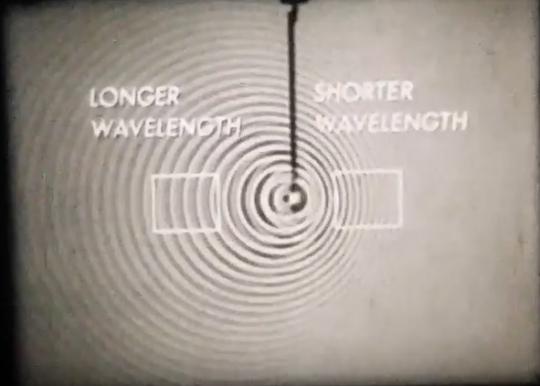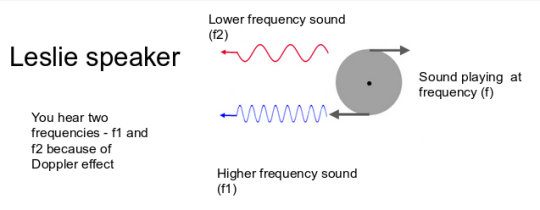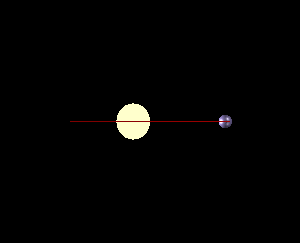#doppler effect
Radar stands for RAdio Detection And Ranging.

The way radar guns work to find out the speed of an object is that a high frequency radio wave is transmitted from the gun onto the object whose speed you would like to measure.
This wave bounces off the moving object and then returns back to the radar gun.

A circuit in the gun amplifies the signals and adds them together.
Case – I
Let’s consider a stationary object. Any wave that hits the object reflects back and get back to you in the same frequency.
Since the frequency of the received wave is same as the transmitted wave, you get another wave with the same frequency when you add them up.
Case – II
Now if that object is moving with some velocity, your reflected wave would be “Doppler shifted”.

Doppler effect is the increase (or decrease) in the frequency of sound, light, or other waves as the source and observer move toward (or away from) each other.

This means the frequency of the received wave is different than the transmitted wave. And when you add those two signals of different frequencies up you get a pulsating beats effect:

Since each velocity corresponds to a particular beat frequency, radar guns use the beat frequency as a measure to find out how fast an object is moving.
For example, if 60mph corresponds to a 20 Hz beat frequency.
If you are moving at 100mph instead (say), the beat frequency measured by a cop’s radar gun would be higher than 20Hz.

And that’s how cops know exactly how fast you were going! Have a great day! Drive safe!
** This post masks a huge chunk of engineering of that goes behind making one of these for the sake of simplicity.
But if you would like to learn more about the circuit underlying radar guns, an useful starting point would be this video
The Nobel Prize in Physics 2019 was awarded “for contributions to our understanding of the evolution of the universe and Earth’s place in the cosmos” with one half to James Peebles “for theoretical discoveries in physical cosmology”, the other half jointly to Michel Mayor and Didier Queloz “for the discovery of an exoplanet orbiting a solar-type star.”

In this post we will try to understand how Michel Mayor and Didier Queloz discovered the first ever exoplanet - 51 Pegasi b . Let’s first take the example of a Leslie speaker.
Leslie Speaker
This speaker has two horns from which the sound emerges out,

The two horns are placed on a rotating platform which can spun at high speeds.

Therefore, if you play a tone at frequency ‘f’ and begin to spin the horns, you can make the listener hear a higher frequency(f1) and a lower frequency tone(f2) instead of ‘f’.
If the horns stop spinning, the listener will only hear frequency ‘f’ .
This is due to the Doppler Effect and leads to some really cool sound effects. This video offers a great demo around the 7:30 mark:
Planet or no planet?
In our solar system the Sun, Earth, and all of the planets in the solar system orbit around a point called the barycenter. This is where the center of the mass of the solar system lies at :

This means that the motion of the sun and jupiter looks like so:

Top and side view (exaggerated for more clarity)

This same ‘wobbling’ idea applies to planets revolving other stars as well (called ‘Exoplanets’).
The star moves around in a circle like the horns of a Leslie speaker.
The spectrum of the star when it is moving towards us would be doppler shifted to a higher frequency and when the star is moving away would be doppler shifted to a lower frequency!

Measuring this wobble is one way to find whether a planet is orbiting the star or not.
Michel Mayor and Didier Queloz were awarded the Nobel prize for their discovery of 51-Pegasi b, an ‘exoplanet’ orbiting a sun-like star 51-Pegasi using this technique.
When they published their results in 1995 it was the first exoplanet to be discovered.
Today more than 4,000 exoplanets are confirmed to be in orbit around other stars but their research definitely stands as the cornerstone in what has now become a field of its own.
Source of gifs:NASA , UOregon
* Check out other techniques to find exoplanets here.

Happy Halloween
What exactly is “redshift”?
Redshift is defined as:
a shifttoward longer wavelengths of the spectral lines emitted by a celestial object that is caused by the object moving away from the earth.
If you can understand that, great! But for those of us who cannot, consider the celestial bodies which make up our night sky. Did you think they were still, adamant, everlasting constants? They may seem to stick around forever, but…
Boy, you were wrong. I’ll have you know that stars are born and, at some point, they die. They move, they change. Have you heard about variable stars? Stars undergo changes, sometimes in their luminosity. (We are, indeed, made of the same stuff as stars).
So, stars move. All celestial bodies do, actually. You might have heard about some mysterious, elusive thing called dark energy. Dark energy is thought to be the force that causes the universe to expand at a growing rate. If it is proven to exist, dark energy will be able to explain why redshift occurs.
Maybe you can understand redshift by studying a visual:

These are spectral lines from an object. What do you notice is different in the unshifted, “normal” emission lines from the redshifted and blueshifted lines?
The redshifted line is observed as if everything is “shifted” a bit to the right– towards the red end of the spectrum; whereas the blueshifted line is moved to the left towards the bluer end of the spectrum.
Imagine if you were standing here on earth and some many lightyears away, a hypothetical “alien” was standing on their planet. With this image in mind, consider a galaxy in between the two of you that is moving towards the alien. You would then observe redshift (stretched out wavelength) and the alien would observe blueshift (shortened wavelength).
Here,Symmetry Magazine explains redshift in their “Explain it in 60 seconds” series.
A simple, everyday example of this concept can be observed if you stand in front of a road. As a car (one without a silencer) drives by, the pitch you observe changes. This is known as the Doppler effect. Watch this quick youtube video titled “Example of Dopper Shift using car horn”:
(You may not be able to view it from the dashboard, only by opening this post on the actual blog page. You can watch the video by clicking this link).
Notice how as the car drives past the camera man, the sound changes drastically.
Understanding redshift is important to scientists, especially astronomers and astrophysicists. They must account for this observable difference to make the right conclusions. Redshift is one the concepts which helped scientists determine that celestial bodies are actually moving further away from us at an accelerating rate.
Post link

![[Image source] What exactly is “redshift”? Redshift is defined as: a shift toward lon [Image source] What exactly is “redshift”? Redshift is defined as: a shift toward lon](https://64.media.tumblr.com/tumblr_lqedrn3vaN1qmyxvuo1_500.jpg)